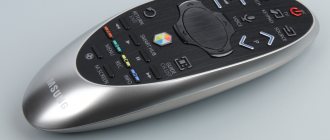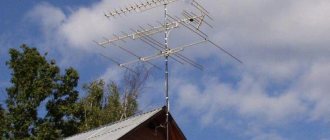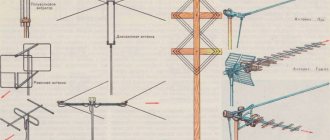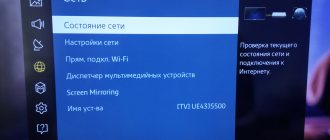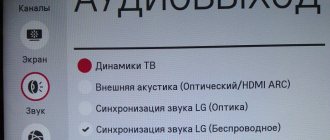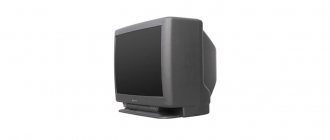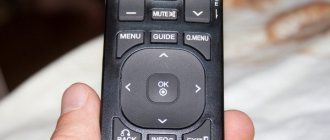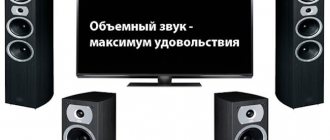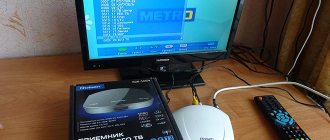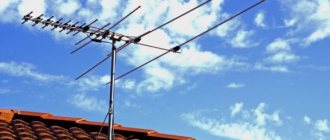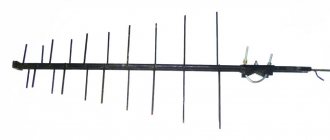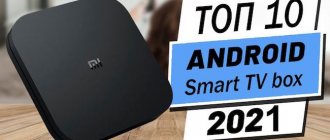To be able to connect to DVB-T2 television channels, you need to buy and install an antenna for digital TV. There are several dozen models of similar devices on the Russian market, which can differ significantly in technical parameters and price. In our article we will find out which is the best DVB-T2 antenna for digital TV for 2021.
- TOP 5 indoor TV antennas
Selenga 105A
- BBK DA18
- Delta K131A.03
- Harper ADVB-2969
- REMO BAS-5340-USB TVJET
- TOP 5 outdoor TV antennas
Locus Zenit-14AF
- Hyundai H-TAE220
- Locus Meridian 07AF Turbo
- LUMAX DA2501A
- HARPER ADVB-2440
- The most powerful antenna for DVB-T2 with amplifier
Strong 21.1-60V Super with Alcad amplifier
- Triton XL-LF with Breeze amplifier
- Why you don't need to strive for an active antenna with a powerful amplifier
- conclusions
Antennas for DVB-T2 and their main types
The DVB-T2 antenna is a small device that is used to gain access to second-generation terrestrial digital television. It connects to the TV directly (new TV models) or indirectly through a digital set-top box (old TV models). Depending on the technical “stuffing”, there are two types of DVB-T2 antennas - active and passive. Let's find out what the difference is between them:
- Passive. They can only receive a signal due to their shape and dimensions. They do not amplify the incoming signal because they do not contain a corresponding device. They do not require connection to the electrical network - they work directly from a cable that connects to the TV/set-top box. The best option for regions with large and medium-sized settlements, where digital communication towers are located close to the antennas.
- Active. They can not only receive a signal, but also amplify it using an auxiliary device. The active antenna with amplifier itself does not require power supply, and it is also connected to the TV/set-top box. However, an amplifier must be connected to a 220-volt electrical network. Active antennas for digital TV should be installed in areas where digital communication towers are located far away and the signal quality is weak. These can be the outskirts of large and medium-sized cities, entire small cities, villages, remote houses, and so on.
Based on the location of the device, indoor and outdoor antennas are distinguished, respectively. They have slight differences in design, although their functionality is quite similar. Outdoor and indoor devices can be either active or passive. Below we will look at each variety in more detail.
Indoor antennas and how to choose them
As the name implies, such television antennas are usually installed in apartments and small houses. The device has compact dimensions for ease of installation. Amplifiers are usually not equipped. When choosing, it is recommended to pay attention to the following technical features:
- The device must necessarily receive decimeter waves (UHF standard), since this is what the digital TV broadcasting standard works with.
- The packaging must indicate whether the device operates according to the DVB-T2 standard. If there is no mark, the device either does not work digitally or is of low quality.
- If you decide to take an indoor antenna with an amplifier, pay attention to the gain level. For areas remote from towers, it is recommended to take a device with a gain of 15-30 decibels.
Outdoor antennas and what to look for when choosing
They are distinguished by their large dimensions and are usually mounted on the roofs of houses. They are usually equipped with an amplifier device that allows you to get a clear, high-quality picture. Can be connected to a long cable (from 5 to 50 meters).
When choosing, the same rules apply as in the previous case - you need to buy UHF-compatible devices, you should pay attention to the packaging, and so on.
The optimal level of signal amplification is 20-40 decibels, adjustable.
Which antenna to choose - examples
The distance to the tower is the main factor when choosing:
- distance to the tower - the further you are from the receiver, the worse the quality;
- buildings in the signal path interfere with the transmission of quality.
- the distance between the antenna and the TV receiver is an important factor in the quality of reception;
- power - high value allows use at a long distance from the tower.
Distance to the tower 5-15 km
For close distances, an indoor option is suitable. A special feature of the model is the possibility of installation without an amplifier. The optimal distance would be no more than 15 km from the repeater.
Indoor antenna - application features
The main factor for a good signal is a good location. In an apartment, as a rule, the only places where the antenna is located are the windowsill and the TV. A short cord or connection cable is a common problem when the device is not placed in the direction of the tower. The way out of this situation is to purchase an extension cord or an additional network cable.
Distance from the TV tower is approximately 25-30 or more km
The power of the receiving transmitter plays a key role. For houses located beyond 25 km from the tower, a small antenna of 60 cm and a power of up to 1 kW is sufficient. Installation towards the tower will help in quality reception.
TOP 5 indoor TV antennas
Let's now look at the rating of indoor antennas with an amplifier for high-quality reception, which are most popular among Russian buyers in 2021.
Selenga 105A
Selenga 105A
A small but quite powerful indoor television antenna with a 12 dB amplifier. The design is highly ergonomic and can even be placed on a table. There is a device for adjusting the amplification power; if necessary, the amplification can be turned off (then the device will operate in passive reception mode). The only major drawback is the rather short cable, which impairs the versatility of the device. The average price is 1000 rubles.
BBK DA18
BBK DA18
An ultra-compact model for television, which has the appearance of a small rectangle. Has a built-in 24 decibel amplifier. Can be installed on any vertical plane or simply placed on a table or shelf next to the window. BBK is a world-famous brand, so the device is well equipped and has a long shelf life. Again, the problem is with the cable - it is short (only one and a half meters). The average price is 1200 rubles.
Delta K131A.03
Delta K131A.03
Old-fashioned, but quite a high-quality model of domestic production for a good reception. It has a good gain level - as much as 40 decibels. Therefore, Delta can be installed in a house that is located away from digital TV towers. The device has a fairly long cable - 3 meters, which enhances its mobility. The main drawback is the lack of fastenings for installation. Experienced craftsmen recommend placing the device on glue or construction plasticine. Price – 1000 rubles.
Harper ADVB-2969
Harper ADVB-2969
A good compact model for installation in an apartment or near the house for stable reception. It has its own powerful amplifier of 30 decibels, which allows the device to be used far from communication towers. Power adjustment is carried out using a knob on the body. It has a built-in block for separating the useful signal from external noise. A major drawback is the short cable length (only 1 meter). The cost of the device is 1100 rubles.
REMO BAS-5340-USB TVJET
REMO BAS-5340-USB TVJET
Another compact model for home television. Boosts the signal by 20-30 decibels depending on environmental conditions. The built-in cable is quite large - almost 2 meters. The device is equipped with a USB connector, which allows you to connect a TV directly to it. The housing is made of high-strength plastic modification, which simplifies the transportation of the antenna. Cost – 1000 rubles.
Connection methods
How you can connect a TV without an antenna depends on the TV model and capabilities in a particular region.
Digital tuner
This method for watching TV has been used for a long time. The digital tuner is a small set-top box (~10*15 cm box), supplemented with an indoor antenna. The method cannot be fully called “digital television without antennas,” but at least you are not dependent on external factors - for example, the weather.
The tuner essentially replaces the built-in receiver, allowing you to watch digital channels rather than analogue ones: it receives the signal, decodes it, and displays it on the TV screen.
Today, TV set-top boxes without an antenna can be purchased at any electronics store - they operate in different frequency ranges and usually allow you to “catch” a limited number of channels. But television via a tuner is free!
Standard set-top boxes are supplied complete with a remote control, power cord and connection cable (hdmi or tulips, or scart + adapter for older receivers). Don’t be afraid of the wrong connection - it’s almost impossible to mix it up; the wrong plug simply won’t fit into the wrong connector. The exception is tulips, but they are connected by color.
- The provider's antenna cable, ethernet is inserted into the set-top box, or it is connected to the network via Wi-Fi.
- Then the tuner is connected to the TV with a suitable cord (preferably HDMI) and the equipment is switched to “on” mode.
- After the first turn on, auto-tuning usually starts, where step by step, following intuitive instructions, you can independently select channels, image format, etc.
After setting up the receiver, digital terrestrial TV should appear, controlled from the remote control of the set-top box.
IPTV
Internet television (tv operates using the internet protocol) provides the best price-quality ratio. To be able to watch digital TV without an antenna, you will need to install a smart TV application on the TV itself or purchase a special set-top box. The second option is suitable for any model of television receiver.
The set-top box is purchased from the provider or an electrical goods store. In the first case, after connecting to the network and TV, all you have to do is enter the login information from your personal account - channels and applications will download automatically.
In the second, you will have to purchase third-party packages of television channels and install the necessary software yourself.
If you doubt your abilities, choose a set-top box from an Internet and television provider; the subscription fee usually includes 100-150 channels, which are often enough.
Smart TV application
Are the previous options not suitable due to the need to purchase additional equipment and hanging cables? You can connect to digital television without set-top boxes: to do this, the TV itself must have an operating system preinstalled (for example, Android). Take care of high Internet speed and high-quality connection. Go to the application store, select the most suitable one:
- Free. VinteraTV, Megogo, Smotreshka allow you to connect a wide range of channels and programs to your TV at no additional cost.
- Paid. Sharavoz TV, IPTV Online, CBilling and other services have a stable connection and offer more than 1000 channels for viewing without an antenna. Before purchasing, you can use a short trial period (1-3 days) to check how well the system works, whether there are any interferences and whether it is worth paying for it.
TOP 5 outdoor TV antennas
Let's now look at the rating of top outdoor antennas for outdoor installation. The devices from our top have good technical characteristics, and their choice is approved by many Russians.
Locus Zenit-14AF
Locus Zenit-14AF
A very cheap, but high-quality antenna for digital TV, made on an aluminum base. It has its own amplifier of 15-20 decibels. Easy to install and holds up well in the wind. The kit includes a long cord of 5 meters, which is very convenient. The main disadvantage is that it is not suitable for small towns and villages, since the gain level is quite modest. Price – 700 rubles.
Hyundai H-TAE220
Hyundai H-TAE220
Let us note right away that the antenna does not have its own amplifier, so in small settlements and on the outskirts of cities its use will be ineffective. In terms of other technical indicators, it is a quite good antenna for digital television. The main advantages are high stability, stable communication reception, simple use (no need to connect to the mains). Another plus is the very low price (600 rubles).
Locus Meridian 07AF Turbo
The main feature of this device with an amplifier is its good filtering of the useful signal (according to the manufacturers, it is 3 dB). The device is made of aluminum, so installing such an antenna is not difficult. The gain is not very good, but decent - 30 decibels. If desired, you can hang it on the wall, although in this case you will have to tinker (the mounting bracket is not included in the package). The average price is 800 rubles.
LUMAX DA2501A
LUMAX DA2501A
Another outdoor antenna with a medium power amplifier (30 decibels). The kit includes a long five-meter cable, which is very convenient if the TV is located far from the antenna. The device is lightweight, easy to install, and maintains high signal quality even in bad weather. However, unlike the same Locus, this model with an amplifier does not include a filter to separate the useful signal from the noise, which somewhat spoils the impression. Price – 800 rubles.
HARPER ADVB-2440
A very non-standard model with an amplifier in design and contents, which has already become a favorite of many Russians. Thanks to its unusual shape, the device has an ideal viewing angle of 360 degrees. Therefore, you can hang it in any position - it will still clearly catch digital TV. The gain here is average (only 30 decibels), although it will do for urban outskirts and small towns. Major disadvantages are a very short cable (only 1.5 meters), a fairly high price (1600 rubles).
TV and digital TV set-top box
Our Blonde talked about whether it is possible to configure an analog TV to watch digital TV here.
Before you figure out what kind of antenna you need for digital TV, you need to resolve the issue with your TV. Devices that went into production and sale after 2012 usually have a built-in digital receiver. In this case, connection is not a problem. It is enough to select the required item in the settings, which switches the signal reception.
If the equipment is a little older, but there is no desire to replace it, a special DVB T2 set-top box comes to the rescue. There are many consoles in stores today that differ in additional functions and design. But the main task is the same - decoding a digital signal into an analog one.
Before choosing a set-top box, you need to familiarize yourself with the antenna sockets of the TV. If necessary, connecting cords must be purchased with the receiver.
The digital set-top box is equipped with three sockets - red, white, yellow. The set includes tulip wires. Not all older TVs are also equipped with three outputs. There are models with two sockets or a SCART output.
If the equipment has only two sockets, you will need to make some efforts in order to select a combination in which the set-top box will function. Don’t be alarmed if one of the wires remains “out of use.”
Borodach spoke in detail about how to switch to digital TV. Read here.
The most powerful antenna for DVB-T2 with amplifier
If you live far from a digital communications tower, then you need to buy a very powerful antenna with a good amplifier. In this case, you will get a good clear picture and pleasant sound while watching.
Powerful antennas should be purchased if you live in a very small locality - otherwise there is no practical use for powerful amplification (you can buy a less powerful device, but the picture will still be of high quality). Below we will look at 2 powerful performance DVB-T2 antennas.
Strong 21.1-60V Super with Alcad amplifier
A powerful outdoor antenna capable of amplifying the signal by 45 decibels. Capable of receiving and modulating a signal at a distance of up to 70 kilometers from the tower. Effectively suppresses external noise and distortion. The device is made on an aluminum base and is recommended to be installed on the roof of a building. It is lightweight and highly stable in strong winds. The average price on the Russian market is 2,500 rubles.
Triton XL-LF with Breeze amplifier
The best digital DVB T2 antenna with amplifier available on the domestic market. When connecting the Breeze amplifier, the gain level is 55 decibels, which allows you to get a stable, high-quality signal even at a distance of 90-100 km to a radio tower. The body is made of aluminum, and to obtain the maximum level of reception it is recommended to install the antenna on the roof of the house. The only major drawback of the device is its price (4,200 rubles).
Why you don't need to strive for an active antenna with a powerful amplifier
Most people prefer to buy a DVB TV antenna with a very powerful amplifier. They are based on a simple rule - the more powerful, the better. But it should be understood that the device should be selected for the specific technical conditions of the site (overall signal level, presence of interference, reception quality, and so on). In most cases, purchasing a device with a powerful amplifier is not only unnecessary, but can also be harmful.
The best option is to purchase a device with an amplifier up to 30 dB. We explain what disadvantages antennas for digital TV with an amplifier of more than 30 dB have and why you should not strive to buy them:
- There is a possibility of signal over-amplification. In such a scenario, the TV and/or set-top box will begin to malfunction or even fail altogether. As a result, a paradoxical situation will arise - you bought a television antenna with an amplifier, but it amplified the signal so much that it became useless.
- The amplifier does not differentiate between a positive signal and extraneous noise. As a result, the picture will not become much clearer, since the noise level will significantly worsen it. It is the antenna design itself that “pulls” the useful signal, and not the amplifier device.
- The amplifier will act as the weak link in the installation. Practice shows that an amplifier often breaks down for internal reasons, it is struck by lightning, it can suffer from changes in temperature and voltage in the network. By the way, about voltage - do not forget that the amplifier will have to be connected separately to the network.
Installing an antenna with an amplifier of more than 30 dB is usually required at a great distance from a radio tower, where the level of reception of a digital TV signal is unusually low. These are usually deep urban outskirts or sparsely populated towns or villages.
In this case, installing a device with a powerful amplifier may be justified. In other cases, a regular indoor or outdoor antenna with low gain for DVB-T2 television will do. You can also make your own antenna.
Step by step antenna cable assembly
The coaxial cable is connected to the F-plug in the following sequence:
1. Carefully remove insulation from the end of the cable intended for connection. There should be about 1 cm from the edge.
2. Bend the braid and foil to the side of the cable where the outer sheath is still intact.
3. The central core must be freed from the inner insulating layer. To do this, cut it and remove it from the core; its length as a result of this step should be approximately 7 mm.
4. Screw the plug onto the wrapped layer of braid.
5. Trim the core so that about 2-3 mm of wire remains.
6. Screw the second half (adapter) over the inserted part of the plug. In principle, its presence is not necessary, but by using a “double” plug, you will improve the direct contact between parts of the equipment, which will ultimately have a positive effect on the quality of TV signal reception.
Connecting a cable to an old Soviet-style plug, or a new, compression one, most often goes like this:
- Disassemble the plug by unscrewing the contact from the body itself.
- Place the housing on the cable.
- Cut 1 cm of the outer part of the wire, remove the insulating material.
- Cut the braid by 5 mm.
- Where there is free space after trimming the braid, strip the insulation to expose the main core.
- Insert the wire into the socket located in the metal half of the plug.
- Use pliers to pinch the stripping material around the sheath so that nothing touches the center core.
- Tighten the fastening screw.
- Screw a plastic tip onto the metal part.
conclusions
- To get DVB-T2 cable television, you need to buy and install an antenna of the appropriate category, and there are several dozen models on sale that differ greatly in technical parameters and reception level.
- The following models are suitable for outdoor installation: Selenga 105A, Delta K131A.03, Harper ADVB-2969. Home models - Locus Zenit-14AF, LUMAX DA2501A, HARPER ADVB-2440.
- Powerful, productive antennas should only be purchased if you live far from digital TV towers. Otherwise, it is much more profitable to buy a less powerful device, which will still give a good picture.
- The best DVB antenna is Triton XL-LF. It is capable of amplifying the signal by 55 dB, which is convenient for remote settlements. However, it is not recommended to use it in large and medium-sized cities.
Popular questions
As users connected antennas to their TV receivers, the most popular questions were identified.
What is the difference between a “crab” and a coupler?
“Crab” is different in that its power is divided into equal parts between TVs. The taps produce a power distribution of no more than 6 dB. The signal strength depends on the number of connected subscribers. The more there are, the stronger the signal.
In apartment buildings, the connection diagram to a common house television is one large “crab” with many branches.
What determines the quality of a TV signal?
High-quality television signal reception directly depends on the height of the antenna. In addition, the presence of a large amount of serious interference, for example, high-voltage power lines, can have a significant negative impact. This problem can be solved by choosing the right antenna.
When should I buy an antenna amplifier?
An amplifier is used only when the signal strength is not enough to correctly transmit sound and image.
Otherwise, the amplifier may even have a negative effect on your equipment. Over-amplification wears out the equipment, and violations of the correct operation of transmission reception occur, such as channels overlapping each other.
With a consistent approach to the task, users usually easily cope with connecting the antenna to the TV. Having previously selected the desired model of cable, plug and antenna, and determined whether additional devices are needed, you can begin installation.
How useful was the article to you?
